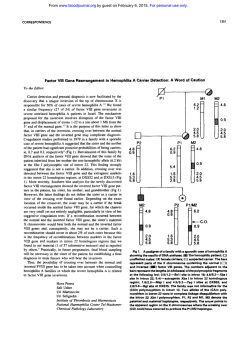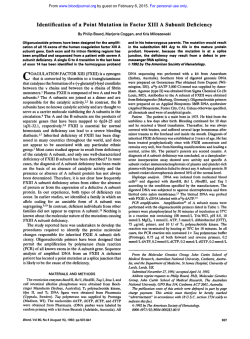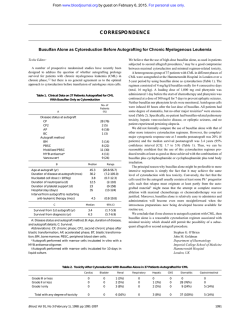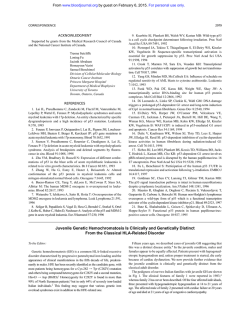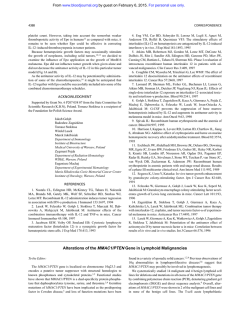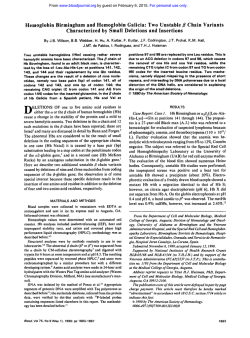
Hereditary Antithrombin Deficiency: Heterogeneity of the
From www.bloodjournal.org by guest on February 6, 2015. For personal use only. Hereditary Antithrombin Deficiency: Heterogeneity of the Molecular Basis and Mortality in Dutch Families By H.H. van Boven, R.J. Olds, S.-L. Thein, P.H. Reitsma, D.A. Lane, E. Briet, J.P. Vandenbroucke, and F.R. Rosendaal We studied the molecular basis and genetic heterogeneity of hereditary antithrombin (111) deficiency in nine Dutch families. Polymerase chain reaction (PCR) amplification and direct sequencing of all antithrombin gene exons and flanking intronic regions identified mutationsin eight families. Given the opportunity t o correlate the molecular basis with survival, we addressed the relevance of molecular defects t o mortality in inherited antithrombin deficiency. The defects included single nucleotide deletions (7671 del G, 7768-69 del G ) and insertions (5501 ins A, 2463 G-+TC) that lead t o frameshifts, a single base substitution 15381 C-T (129Arg-+ stop)] leading t o a premature termination codon, and single base substitutions resulting in amino acid substitutions [2652 A 4 (63TyrSer), 13380 T 4 (42111etThr). and 13407 G-T (430Cys-+Phe)]. All affected individuals were heterozy- gous for the defects. Previously we foundin Dutch families that antithrombindeficiency did notlead t o higher mortality compared with the general population. In accordance with these findings, w e observed no excess mortality in the nine families [Observed:Expected, 52:52.6; standardised mortality ratio(SMR] 1.0,95% confidence interval (Cl), 0.7-1.31. Our findings confirmeda considerable genetic heterogeneity underlying antithrombin deficiency. We therefore concluded that the lack of excess mortality in these families is not caused b y a Dutch mild defect. We suggest that thelongevity is not affected by molecular defects in the antithrombin gene and hypothesize that differences in mortality or natural history between families most likely result from other (genetic) risk factors. 0 1994 by The American Society of Hematology. A thrombosis related to the age of onset was highest between years 15 and 40, Hirsh et a18 made a strong case for prophylactic use of anticoagulants between the ages of 15 and 40 years. Similarly, if certain molecular defects can be shown to be associated with clinically severe phenotypes, a case could be made for prophylactic anticoagulant therapy in individuals with such genotypes. At present, no studies have been designed to address this matter. Previously, we studied the natural history of 10 Dutch kindreds with regard to mortality? We found no excess mortality in comparison with the general population. From that study we concluded that, in general, antithrombin deficiency did not appear so severe a disease as to warrant long-term prophylactic anticoagulation of asymptomatic gene carriers. Although this was the first study inwhich the natural history of antithrombin deficiency was studied in a formal design, two issues were correctly r a i ~ e d :first, ~ whether for some reason these Dutch families all had mildforms of the disease, for instance due to the presence of one “Dutch” molecular defect with mild clinical expression in these families; and second, whether the overall mortality figures might mask differences in mortality between individual families, related to the underlying defect. In the present study we investigated the molecular basis NTITHROMBIN IS A natural anticoagulant that exerts its action by inhibiting clotting factor IIa (thrombin), factor IXa, and factor Xa. The gene coding for the antithrombin protein has been localized to chromosome 1q23-25, and its complete sequence was recently elucidated.’ Basedon structural and sequence homology, antithrombin belongs to the serpin (serine proteinase inhibitor) family of proteins. Hereditary antithrombin deficiency is a rare autosomal dominant disorder. A variety of underlying molecular defects have been identified.’ Inherited antithrombin deficiency may be classified into two major types based on the results of functional and immunologic assays. Type I deficiencyis characterized by reduced functional and immunologic antithrombin levels, both at approximately 50% of normal. Type I1 deficiency results from the presence of a variant functionally inactive protein with almost normal antigen levels, but functionally the levels are reduced. Type I1 deficiency may be further subclassified into variants with reactive site defects, heparin-binding defects, and variants with pleiotropic effects? It iswell recognized that hereditary antithrombin deficiency is associated with a risk of thromboembolic disease. However, it is still a matter of debate whether the clinical seventy of thromboembolic episodes and, hence, mortality might vary between families. It has been suggested that the underlying defect might be relevant to clinical ~everity.~ Many families have been reported since Egeberg first described antithrombin deficiency in 1965.5The type I1 variants with reduced affinity for heparin seem to be associated with a low frequency of thrombotic episodes, except when present in homozygous individuals: Excluding the heparin-binding variants, cumulative incidences of thrombosis of 15% to 100% have been suggested for inherited antithrombin deficiency.’ It is important to know if some forms of deficiency are truly more clinically severe than others, as such information would play a decisive role in clinical management. For example, to decide that long-term prophylactic treatment with anticoagulants is required for (a)symptomatic carriers, the risk of thrombosis should outweigh the disadvantages of long-term anticoagulant treatment. Because the incidence of Blood, Vol 84, No 12 (December 15), 1994: pp 4209-4213 From the Department of Clinical Epidemiology, and the Haemostasis and Thrombosis Research Center, University Hospital, Leiden, The Netherlands: the Department of Haematology, Charing Cross and Westminster Medical School, London; and the Institute of Molecular Medicine, John Radcllffe Hospital, Oxford, UK. Submitted March 24, 1994: accepted August 18, 1994. Supported by Ter Meulen Fund, Royal Netherlands Academy of Arts and Sciences, and by The Wellcome Trust, UK. Address reprint requests to F.R. Rosendaal, MD, PhD, Department of Clinical Epidemiology, Sldg 1, CO-P University Hospital, PO Box 9600, 2300 RC Leiden, The Netherlands. The publication costs of this article were defrayed in part by page charge payment. This article must therefore be hereby marked “advertisement” in accordance with 18 U.S.C. section 1734 solely to indicate this fact. 0 1994 by The American Society of Hematology. 0006-4971/94/8412-0012$3.00/0 4209 From www.bloodjournal.org by guest on February 6, 2015. For personal use only. VAN BOVEN ET AL 4210 of antithrombin deficiency in nine families to identify the the possibilityof a mild underlyingdefectsandaddress "Dutch" defect with regard to mortality. MATERIALS AND METHODS Patients. Of the 10 families from the previous mortality study," 9 families were available for further investigation. In each family, venepuncture was performed in two individuals previously known to be affected by plasma phenotype. The blood samples were collected from the antecubital vein in 1/10v01 of 0.11 mmol/L trisodium citrate. Plasma was prepared by centrifugation for 10 minutes at 2,000g at 10°C and stored at -70°C until use. Antithrombin assays. Antithrombin antigen concentration was measured by immunoelectrophoresis according to the methodof Laurell.gbAmidolytic heparin cofactor assays (Chromogenie, Molndal, Sweden) were used for antithrombin activity measurement. The presence of a variant antithrombin protein was investigated by crossed immunoelectrophoresis (CIE) in the presence of heparin."' Southern blot analysis. Genomic DNA extracted from blood leukocytes by standard methods was digested with restriction enzymes Pst I, EcoRI, BamHI, and HindIII, using conditions recommended by the manufacturers (New England Biolabs [Beverly, MA]and Promega [Madison, WI]). The digested DNAwas fragmented by gel electrophoresis and transferred onto nylon membranes (Hybond, Amersham, UK) by Southern blot. These membranes were subsequently hybridized to an antithrombin cDNA probe that had been labeled with ["Pld-cytidine triphosphate (dCTP) by random priming (Megaprime, Amersham, UK). After hybridization, the membranes were washed at high stringency and autoradiographed between intensifying screens at -70°C. DNA sequence analysis. The antithrombin exons and their flanking intron regions were amplified by polymerase chain reaction (PCR) using biotinylated primers and conditions previously described." The single-stranded DNA was directly sequenced by the dideoxynucleotide method using the nonbiotinylated primer or an internal primer (Sequenase; US Biochemical, Cleveland, OH). All exons and adjacent intron regions were sequenced for each proband. Restriction enzyme unalysis of mutations. Mutations identified by sequencing were confirmed by restriction enzyme digestion of amplified antithrombin gene fragments. When the mutation did not create or abolish a restriction site, a site was created by introducing nucleotide substitutions with mutant oligonucleotides during amplification." Mutant oligonucleotides were designed with a nucleotide substitution close to the 3' end, such thatthe combination of the nucleotide substitution and the mutation created a new restriction enzyme cleavage site. After amplification with the mutagenic primer and a downstream primer, the products were digested with the appropriate enzyme. Digested products were visualized under UV light after electrophoresis in 2% agarose and ethidium bromide staining. Normal subjects served as controls. Sequences of amplification primers and the restriction enzyme sites associated with each mutation are shown in Table 1. In family 3, the mutation was confirmed by allele-specific priming of the PCR, as previously described." Mortality analysis. The mortality data of the nine families were analyzed by the family tree mortality ratio (FMTR) method as previously described.' The method involves the application of the standard technique of indirect standardization on a cohort formed from the pedigrees under study. In the cohort we included all individuals with a probability of 0.5 or higher of carrying the defective gene, ie, all siblings and offspring of carriers and theparents. The mortality in the cohort is compared with the general population, adjusted for differences in age, gender, and calender period by indirect standardization. This method of a comparison of observed (0)number of cases (in the cohort) and expected (E) number of cases (in the population, standardized)-the ratio 0:E-is knownasthe standardized mortality ratio (SMR).'' We omitted the first two decades of life for the observed and for the expected number of deaths. The reason is thatthosewhopassedonthe gene to their descendents hadto liveuntil reproductive ageand reproduce; consequently, if these tirat decades in which members of previous generations "had to live" were included, no deaths would be observed, but the accrual of person-time would yield expected cases, ie, a biased (low) SMR. RESULTS Antithrombin assays. The results obtained by functional in and immunological antithrombin assays are summarized Table 1. All the affected individuals had reduced functional and antigen levels, compatible with type I antithrombin deficiency. CIE in the presence of heparin confirmed the absence of variant antithrombin with altered heparin affinity in the plasma. Genomic basis for antithrombin deficiency. No evidence for major gene rearrangements was obtained from restriction enzyme analysis of genomic DNA from affected members ofallninefamilies.Directsequencingofamplifiedantithrombin gene fragments identified mutations in eight of the ninefamilies(Table1):fourmutationsweresinglebase substitutions (families 2, 3, 7, and S), two were single base deletions (families S and 6), one was a nucleotide insertion a substitutiodinsertion of two nucle(family 4), and one was otides (family l). For each individual examined, sequencing of the remaining exons and flanking intron regions did not show further mutations. Mutations were confirmed by sequencing the appropriate antithrombin gene fragments in a second affected member PCR from each family and by restriction analysis of products (data not shown). The deletion of a G in exon 4, codon 320 (family S ) creates a Fok I site, while a Dde I site is created by the A< substitution in codon 63 (family 2). Deletion 4 (family 6) and the T+C of G from codon 353 in exon substitution in codon 42 1, exon 6 (family 7) abolishes sites for BstNI and Mbo 11, respectively. Amplification primers were designed to create a cutting site for M b o I1 in the allele carrying the C+TC mutation in codon - 1 of family 1 and A insertion in a site for Dde I in the mutant allele with an codon 169 in family 4. The G+T substitution in codon 430 (family S) could not be confirmed by this strategy. However, a BsrNI site was created instead in the normal allele; digestion of PCR products with the enzyme showed that about SO% of the amplified product did not cut. In family3 allelespecific priming of the PCR was used to confirm the C+T substitution in codon 129. In the affected members of family 9, sequence analysis of all the coding regions and flanking introns did not show any mutation. Sequence analysis showed that affected members were heterozygous for a previously described Pst I polymorphism in exon 4, confirming the presence of two copies of the gene. Mortalivanalysis. Thenumbersofindividualsaged 2 2 0 years contributed to the study by each family are shown inFig 1. Theobservednumberofdeathsinallfamilies combined was 52. The expected number of deaths based on population mortality figures was 52.6, which resulted in a relative mortality of 1 .O [O:E, 5252.6; SMR, 1.0; 95% con- From www.bloodjournal.org by guest on February 6, 2015. For personal use only. 421 l HEREDITARY ANTITHROMBIN DEFICIENCY Table 1. Antithrombin Gene Mutations in Dutch Families Family No. Nucleotide Position AcidMutation Exon % Antigen Activity 12 cased NR, Codon, family)Amino 80%-120% Change TC Frameshift, stop codon 32 C 63 Tyr T 129 Arg stop 2 2463 G 2 2652 A 3A 5381 C 3A 5501 +A 169 frameshift, stop codon 192 4 7671 -G 320 frameshift, stop codon 331 4 7768-69-G 353 Gly -t Val splice + -+ -+ + 40 33 44 42 51 49 Ser 39 36 40 50t Restriction Enzyme Site Oligonucleotide Position - Oligonucleotide Sequence (5' 3') Mbo H* 2443-2462 Dde I 27 17-2698 TGGAGATACTCAGGGGTGAC GTTGCAGCCTAGCTTAACTTGGCA 2370-2393 GGTTGAGGAATCAlTGGACTTG 2860-2839 CTTCTGGGACTGCGTGAICT 4240 Allele-specific priming Dde I* 5480-5502 GTGAGTTGGTATATGGAGCCIA 49 45 50 45 Fok I 5630-5609 7617-7636 GTCTTCAGCAAAGCAGTGT GGTGCTGCAGGAGTGGCEGt 46 38 46 46 BsNl CTTCCACTTTTGGTCAGACTAC 7831-7810 751 4-7533 AGGTGCTTGAGTTGCCCTTC site 6 13380 T 6 13407 G -+ + C 421 Ile T 430 Cys - - + 49 46 44 60 51 41 50 Thr + Phe ? 49 45 45 55 46 50 49 Mbo II BsNl* 7831-7810 13235-13255 13517-13495 13387-13406 13517-13495 CTKCAC'TTTTGGTCAGACTAC CTGCAGGTAAATGAAGAAGGC TGCAGAGTCCATlTATAATGTG GGGCAGAGTAGCCAACCCTG TGCAGAGTCCATlTATAATGTG Restriction enzyme sites created artificially, using primers in which artificialbase substitution is underlined insequence column. Nucleotide numbering corresponds to sequence data, Olds et al.' The first listed primer is complementary in sequence to the noncoding strand. t In this family, only one individual was available venepuncture. for *Artificial base to remove natural restriction site for Fok I that would have resulted i n a similar size for two bands, making it difficult to distinguish between two or three bandsafter digestion fidence interval (CI), 0.7-1.31. For most families no excess mortality in comparison with the general population was apparent, although due to the small number of individuals in some families, the 95% CIS remained wide. Finally, we considered the possibility that differences in the underlying mutations might lead to variation in mortality. We hypothesized a priori that the defects affecting a splice site or leading to a frameshift and premature stop codon are severe defects, as in these cases the allele is rendered fully inactive with no protein production from the mutant gene. This is analogous to the clinical severity in other disorders, eg, hemophilia. The data showthat for the families with these null mutations (families 1, 3, 4, 5 , and 6) no excess mortality was observed (O:E, 30:30.9; SMR, 1.0; 95% CI, 0.7-1.4). Similarly, there was no difference in mortality in the families with the remaining mutations (substitutions) (O:E, 21~20.6;SMR, 1.0; 95% CI, 0.6-1.5). DISCUSSION I o . o l , l I , I I I I , I l(8) ~ ( I I 3(6) ) 4(6) 5(28) 6(29) 7 ( 6 ) 8(26) 9(11) Family (no of individuals) I , I null all mutations Fig 1. M o r t a l i i in antithrombin-deficient families. We investigated the molecular basis in families with inherited antithrombin deficiency and found that mortality was not related to the actual characterized defects. The majority of defects underlying type I antithrombin deficiency are unique events in single kindreds. More than 40 distinct mutations have been reported in the literature.2 In our study, eight defects were defined as the molecular bases of Dutch antithrombin-deficientfamilies. Seven mutations were novel, whereas a C-+T substitution in codon 129, which replaces arginine by a premature termination codon, has been reported eight times previously.*This latter substitution occurs within a CpG dinucleotide, a recognized site for recurrent mutation, but formal haplotype analysis of the mutant alleles would be necessary to distinguish whether the mutations had an independent origin or whether a founder effect was present. From www.bloodjournal.org by guest on February 6, 2015. For personal use only. VAN BOVEN ET AL 4212 Threecategories of mutations giverisetotype I deficiency. Four mutations produced prematuretermination signals, either by direct substitution or by shifts in the reading frame of translation; this represents the most common basis of type I antithrombin deficiency.’ No evidenceof truncated protein was found in the plasma in any of the four families with these mutations in this study, suggesting that either the mutant mRNA is nottranslated or that anytranslated protein either is not exported from hepatocytes oris highly unstable. A second mechanism is the substitution of single amino acids. While this would be expected to give rise to a variant protein (type I1 deficiency), a small number of substitutions have previously been identified as the basis of type I deficiency. We report here three novel amino acid substitutions in thenineDutch kindreds: 6 3 T y ~ S e r ,421Ile+Thr, and 430Cys-tPhe. In principle,thesemutationsmayrepresent rare polymorphisms ratherthan causative defects. Four arguments can be given to make the causative relationship plausible. First, the mutations werethe only abnormalities detected after sequencing all exons for each individual. Second, Tyr at position 63 and Ile at position 421 are highly conserved between serpins,ls suggesting that they have importantstructural roles. The structural role of 43OCys is even more obvious as it forms a disulphide bond with 2 4 7 C ~ s . Third, I~ for each mutation we observed cosegregationwith antithrombin deficiency. Finally, we tested 68 normal alleles for the three mutations but found none. The final mechanism that can be inferred from the observed mutations is a defect in mRNA processing. The mutant allele in family 6 has a deletion of G at either position 7768,whichisthelastnucleotide of exon 4, or position 7769, the first nucleotide of intron 4. Either of these two possibilitieswouldaffectthe exon 4-intron4 splice site. AbnormalmRNAprocessinghas been shown previously fromanother antithrombinmutationthataffectedthelast nucleotide of exon 3A.” In one family (family 9) themutation remains uncharacterized; we were unable to detect eithera major rearrangement of the antithrombin gene or a minor mutation, despite repeated sequence analysis. The affected individuals have typical typeI deficiency as judgedby plasma antithrombin assays (Table l), and several affected family members have been identified in the two generationsavailable for study.A mutation may be present in the unsequenced regions of the antithrombin gene, in the introns, or in 5‘ and 3’ flanking sequences. Alternatively, the mutationmay lieoutsidethe antithrombin gene and segregate independently of the antithrombin locus; furtherinvestigation of family members will be required to distinguish between these possibilities. In the mortality study no excess overall mortality (O:E, 52:52.6; SMR, 1.0; 95% CI, 0.7-1.3) was found for these families that were part of a previous analysis.’ The inclusion only, or predominantly of one, mild “Dutch” antithrombin defect does not explain our finding of a normal life expectancy in hereditary antithrombin deficiency as a variety of molecular defects underlying the deficiency were found. In fact, the majority of mutations we found led to premature stopcodons thatpredict thecompleteabsence of protein product from the mutant allele. Even among families with this drastic type of mutation, null allele mutations, lifeexpectancy appears to be normal. This may seem to be in disagreement with the experience of some familieswith antithrombin deficiency or with previous reports. The latter may be due to overrepresentation of families with dramatichistories in case reports, which seems a likely and almost unavoidable result of selective attention of physicians who are naturally drawn to such families. Our data render it unlikely that the antithrombin gene itself is involved in setting the clinical course at the level of overall mortality. This still does not rule out the possibility of families with, in retrospect, a severe course, ie, a high number of thrombotic episodes or deaths. Most likely, other genes or environmental factors have then played a role. Only recently a high prevalence of a novel inherited abnormality of the coagulation system, a poor response to activated protein C, was found.18 With the emergenceof common genetic risk factors, it becomes likely that some families or generations of families carry the burden of other abnormal genes that lead to differences in phenotype, and environmental factors may aggregate in families or generationsof families. As this study is limited tooverall mortality and theantithrombin gene, furtherfamily studies should investigate thepossibility of a genetic basis for the variety in clinical expression and of clinical morbidity. ACKNOWLEDGMENT We thank Dr H.R. Biiller and Dr J.W. ten Cate (Academic Medical Centre, Amsterdam, The Netherlands) for allowing us to investigate two families of their clinic. REFERENCES I. Olds RJ, Lane DA, Chowdhury V, De Stefano V, Leone G, Thein SL: Complete nucleotide sequence of the antithrombin gene: Evidence for homologous recombination causing thrombophilia. Biochemistry 32:4216, 1993 2. Lane DA, Olds W, Boisclair M, Chowdhury V, Thein SL. Cooper DN, Blajchman MA, Perry DJ, Emmerich J, Aiach M: Antithrombin I11 mutation database: First update. Thromb Haemost 70:361, 1993 3. Lane DA, Olds RI, Conard J, Boisclair M, Bock SC, Hultin M, Abildgaard U, Ireland H, Thompson E, Sas G , Horellou MH, Tamponi G , Thein SL: Pleiotropic effects of antithrombin strand 1 C substitution mutations. J Clin Invest 90:2422, 1992 4. De Stefano V, Leone G : Mortality related to thrombosis in congenital antithrombin I11 deficiency. Lancet 337:847, 1991 S. Egeberg 0: Inherited antithrombin deficiency causing thrombophilia. Thromb Diath Haemorrh 13:516, 1965 6. Finazzi G, Caccia R, Barbui T: Different prevalence of thromboembolism in the subtypes of congenital antithrombin I11 deficiency: Review of 404 cases. Thromb Haemost 58:1094, 1987 7. Demers C, Ginsberg JS, Hirsh J, Henderson P, Blajchman MA: Thrombosis in antithrombin-111-deficientpersons. Report of a large kindred and literature review. Ann Intern Med 116:754, 1992 8. Hirsh J, Piovelli F, Pini M: Congenital antithrombin I11 deficiency: Incidence and clinical features. Am J Med 873348, 1989 (suppl 3B) 9. Rosendaal FR, Heijboer H, Briet E, Buller HR, Brandjes DP, de Bruin K, Hommes DW, Vandenbroucke JP: Mortality in hereditary antithrombin-I11 deficiency, 1830 to 1989. Lancet 337:260, 1991 9b. Laurel1 CB:Quantitative estimation of proteins by electropho- From www.bloodjournal.org by guest on February 6, 2015. For personal use only. HEREDITARY ANTITHROMBIN DEFICIENCY resis in agarose gels containing antibodies. Anal Biochem 15:45, 1966 10. Lane DA, Flynn A, Ireland H, Erdjument H, Samson D, Howarth D, Thompson E: Antithrombin 111 Northwick Park Demonstration of an inactive high MW complex with increased affinity for heparin. Br J Haematol 65:451, 1987 11. Chowdhury V, Olds RI, Lane DA, Conard J, Pabinger I, Ryan K, Bauer KA, Bhavnani M, Abildgaard U, Finazzi G, Castaman G, Mannucci PM, Thein SL: Identification of nine novel mutations in type I antithrombin deficiency by heteroduplex screening. Br J Haematol 84:656, 1993 12. Chang JG, Chen PH, Chiou SS, Lee LS, Perng LI, Liu TC: Rapid diagnosis of b-thalassemia mutations in Chinese by naturally and amplified created restriction sites. Blood 80:2092, 1992 13. Olds RJ, Lane DA. Ireland H, Finazzi G, Barbui T, Abildgaard U, Girolami A, Thein SL: A common point mutation producing type 1A antithrombin 111 deficiency: AT129 CGA to TGA (Arg to STOP). Thromb Haemost 64:621, 1991 14. Breslow NE, Day NE: Rates and rate standardization, in Bres- 4213 low NE,Day NE (eds): Statistical. Methods in Cancer Research, v01 2. Lyon, France, International Agency for Research on Cancer (IARC), 1987, p 48 15. Huber R, Carrell RW: Implications of the three-dimensional structure cy,-antitrypsin for structure and function of serpins. Biochemistry 28:8951, 1989 16. Sun X-J, Chang J-Y: Heparin binding domain of human antithrombin 111 inferred from the sequential reduction of its three disulfide linkages. J Biol Chem 264:11288, 1989 17. Berg LP, Grundy CB, Thomas F, Millar DS, Green PJ, Slomski R, Reiss J, Kakkar VV, Cooper DN: De novo splice site mutation in the antithrombin III (AT3) gene causing recurrent venous thrombosis: Demonstration of exon skipping by ectopic transcript analysis. Genomics 13:1359, 1992 18. Koster T, Rosendaal FR, de Ronde H, Briet E, Vandenbroucke JP, Bertina RM: Venous thrombosis due to poor anticoagulant response to activated protein C: Leiden thrombophilia study. Lancet 342:1503, 1993 From www.bloodjournal.org by guest on February 6, 2015. For personal use only. 1994 84: 4209-4213 Hereditary antithrombin deficiency: heterogeneity of the molecular basis and mortality in Dutch families HH van Boven, RJ Olds, SL Thein, PH Reitsma, DA Lane, E Briet, JP Vandenbroucke and FR Rosendaal Updated information and services can be found at: http://www.bloodjournal.org/content/84/12/4209.full.html Articles on similar topics can be found in the following Blood collections Information about reproducing this article in parts or in its entirety may be found online at: http://www.bloodjournal.org/site/misc/rights.xhtml#repub_requests Information about ordering reprints may be found online at: http://www.bloodjournal.org/site/misc/rights.xhtml#reprints Information about subscriptions and ASH membership may be found online at: http://www.bloodjournal.org/site/subscriptions/index.xhtml Blood (print ISSN 0006-4971, online ISSN 1528-0020), is published weekly by the American Society of Hematology, 2021 L St, NW, Suite 900, Washington DC 20036. Copyright 2011 by The American Society of Hematology; all rights reserved.
© Copyright 2025
